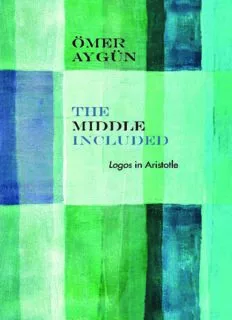
Logos in Aristotle PDF
Preview Logos in Aristotle
the middle included series editor John Russon REREADING ANCIENT PHILOSOPHY THE MIDDLE INCLUDED Logos in Aristotle Ömer Aygün northwestern university press • evanston, illinois Northwestern University Press www.nupress.northwestern.edu Copyright © 2017 by Northwestern University Press. Published 2017. All rights reserved. Printed in the United States of America 10 9 8 7 6 5 4 3 2 1 Library of Congress Cataloging-in-Publication data are available from the Library of Congress. Except where otherwise noted, this book is licensed under a Creative Commons Attribution-NonCommercial-NoDerivatives 4.0 International License. To view a copy of this license, visit http://creativecommons.org/licenses/by-nc-nd/4.0/. In all cases attribution should include the following information: Aygün, Ömer. The Middle Included: Logos in Aristotle. Evanston, Ill.: Northwestern University Press, 2017. For permissions beyond the scope of this license, visit www.nupress.northwestern.edu An electronic version of this book is freely available, thanks to the support of libraries working with Knowledge Unlatched. KU is a collaborative initiative designed to make high-quality books open access for the public good. More information about the initiative and links to the open-access version can be found at www.knowledgeunlatched.org. Canım annemle babam Güzin ve Birol Aygün’e contents Acknowledgments ix Abbreviations xi Preface xiii Introduction: The Question and the Method 3 Chapter 1: Being (Logos in the Categories) 23 1. Homonymy 23 2. Synonymy 30 3. Recapitulation and Reorientation 40 Chapter 2: Potentiality (Logos in On Interpretation) 43 1. The Inherence of Logos 43 2. Potentiality 51 3. Recapitulation and Reorientation 61 Chapter 3: Natural Motion (Logos in the Physics) 63 1. The Natural 63 2. The Organic 75 3. Recapitulation and Reorientation 86 Chapter 4: Animal Motion (Logos in On the Soul) 89 1. Sensation 90 2. Locomotion 101 3. Recapitulation and Reorientation 110 Chapter 5: Action (Logos in the Nicomachean Ethics) 113 1. Habit 114 2. Positive State 123 3. Character 130 4. Recapitulation and Reorientation 142 Chapter 6: Speech (Logos in the Politics) 145 1. Animal Communication 146 2. Human Speech: From “Letters” to “Words” 155 3. Human Speech: From “Words” to “Sentences” 168 4. Logoi: Definition, Account, and Law 178 Conclusion 189 1. Overview 189 2. The Human Condition: The Cycloptic and the Oedipal 194 3. Nous 208 Notes 211 Bibliography 249 General Index 261 Index Locorum 267 acknowledgments I would like to thank the Department of Philosophy at Pennsylvania State University, which provided me an educational and therefore philosophi- cal environment between 2001 and 2005, the Fulbright Foundation which granted me optimum work conditions for research in 2005– 6, and the Proj- ects of Scientific Research at Galatasaray University which enabled me to turn my dissertation into this book. I am deeply grateful to Robert D. Metcalf and Eli Diamond for their detailed notes and fair criticisms concerning the text in its manuscript form; to the members of the committee of my dissertation on which this book is based, Daniel Conway, Veronique Fóti, Christopher P. Long, and Mark Munn, for their suggestions and encouragement after reading the earliest version of this book; and also to Rémi Brague, Pierre Pellegrin, Jean- Louis Labarrière, and Annick Jaulin for their insightful remarks during my presen- tations of parts of it. I am also very much indebted to my friends, Katherine Loewy, Eric Sanday, Hakan Yücefer, Sean D. Kirkland, David Bronstein, Gregory Recco, William Harwood, Refik Güremen, Ali Çakır, and Michael Schleeter, for their companionship and challenges. I cannot express enough my indebtedness to John Russon who directed my dissertation with immense philosophical motivation and genuine friend- ship, and honored my work by including it in its present form in the series “Rereading Ancient Philosophy” at Northwestern University Press. I am also grateful to Maggie Grossman, Henry Lowell Carrigan, Anne E. Gendler, and Nathan MacBrien at the Northwestern University Press for their help during the editorial preparation of the book in its published form. Finally, I am most indebted to my wife, Ayşenur Nuhoğlu, for the con- stant support and diligent criticism she brought to these pages. Indeed, none of the above is to be held responsible for any shortcomings in the following, but the rest of it could not be written without them. ix
Description: